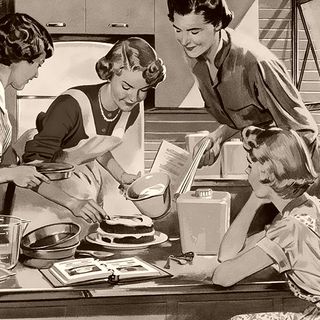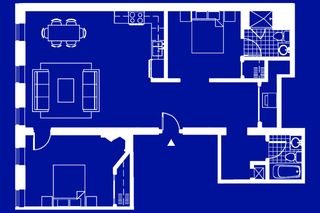
How the Design of India’s Family Flats Is Changing
We asked four architects in India for a peek at the blueprints.

Indian cities are growing, and the lifestyles of Indian families are changing. We spoke to four architects and designers from around the country to get an insight on how Indian family life and culture influence their designs. These interviews have been edited for length and clarity.
THE SWADDLE: What considerations do you take into account when designing homes for Indian families in the big metros?
Ambrish Arora, Founding Principal, Lotus: First and foremost, we consider their lifestyles, the balance between privacy and fostering interaction. Followed by light and ventilation, storage requirements, material durability and how they age, and multi-functionality of spaces.
Mukul Arora, Founding Principal, DADA: Generally speaking, there is a growing aspiration regardless of budgetary constraints and location, to create a habitat that is sophisticated and imaginative. Our work stresses on creating designs that evolve from an expressed or imagined lifestyle and one that is not just function or form based. The new generation of home owners is open to a way of life that balances comfort with ‘everyday luxury’; perhaps a bit of hedonism as well.
Sanjay Mohe, Founding Principal, Mindspace Architects, Bangalore: When it comes to designing homes in a city, one has to work with several constraints. These are about location, the area of the house, the required efficiency of the plan, economics, travel distance… One has to evaluate all these variables and choose the best option. As a planner, you have control on very few of these variables, depending on the size of the project and you try and do your best dealing with these planning issues. Choosing right construction technology is of prime importance, something that complements local conditions, gives a quality product, speeds up the work, saves on the materials, energy and therefore is economical and eco-friendly.
Namrata Mehra, Studio Director, Godrej Properties Design Studio: We have to be able to plan for regional variability. Customer expectations of space change significantly between Delhi, Bangalore, Pune and Mumbai as do regulatory norms. Innovation stems from using these variations as opportunities to develop differentiated products. At the outset, we try and understand the unique set of challenges being addressed with every new development as well as the demographic profile of intenders who may choose to make a home there.
THE SWADDLE: Are there any specific cultural, religious, or social constraints or preferences you have to take into account?
AA: We have to consider the need for a pooja room. Often we also make considerations for Vastu. Further, we have to keep in mind whether it is likely to be used as a ‘barefoot’ home or with shoes – life choices such as that that definitely affect the material palette.
MA: The more affluent client group tends to get more religious and Vastu compliant; for obvious reasons of maintaining or enhancing their affluence! Users are expecting larger sizes for their rooms and spaces; paying much more attention to back of house and services; bathrooms and dressers are now competing with bedrooms in terms of size and detail. Most homeowners/clients want to integrate technology and things like automation as an essential need rather than a talking point.
SM: Climate does have an influence on the life style, house forms developed in Rajasthan to keep dry heat and dust away are very different from those of Kerala, where verandas are important and you want breeze to come on to the body to deal with hot humid weather.
Different economic groups would have different social responses. In an affordable housing segment where indoor space is extremely limited activities spill over in to the common corridors that become multi activity spaces, where elders read the newspaper, kids play cricket, women do cooking preparations, same place is used for sleeping in the night and also during festivities, idols are installed and worshiped in the same place. So the common corridor becomes an activity hub, living room of that floor.
However the requirements of community space change as the economic bracket changes. In a middle class development, the interaction happens by choice and not by compulsion as in the earlier case.
NM: Social constraints emerge at the planning stages with respect to shared spaces and common resources. There is resistance to inclusion of smaller typologies within developments with most customers recommending dedicated towers for 1-bedroom apartments. Owners of 3 or 4 bedroom apartments do not necessarily want to share elevator lobbies or common areas with residents of 1 bedroom apartments. The assumption is for smaller spaces to be occupied by single people/less well to do families that would impact the nature of the community.
THE SWADDLE: What are some of the features that families are requesting?
AA: Today, people are requesting walk-in closets, two kinds of kitchen spaces – one where main cooking happens by the staff and a smaller open pantry/European kitchen used by the family, and veranda spaces to be green where possible.
SM: Emphasis is on creating most efficient compact plan with minimal wastage of space and making sure that every corner of the house gets natural light, air and a view without compromising privacy. Access to landscaped play areas where a child can reach without crossing a vehicular road becomes important.
NM: Families are evolving and demanding spaces that address their needs. Large families moving from congested inner city areas are now looking for connected apartments on one floor. Families are looking to purchase apartments as a group ensuring each nuclear family has its own security while maintaining established everyday connections. This brings about interesting retrofits and families are looking towards interior designers to address unique requirements. Duplexes are losing some of their gloss with most inter-generational families opting out of living spaces that require frequent level/grade changes.
THE SWADDLE: How do you think about multi-generational living in tight urban spaces?
AA: Here the need is for privacy for young couples – so bedrooms are being designed in compact suite like manner. Separate from the main “living room,” which is a multi-generational family space.
MA: The degraded environment is becoming a new concern for few home owners as a result they are now questioning the benefits of age old built traditions such as natural ventilation and degree of interaction with the outdoors. Certain aspects remain the same. People still want a maintenance free house and sometimes extend that logic to the facade as well! Concern for Security (both physical and visual), especially in case of villas, and its potential negative fallout on the threshold design is something we have to be careful of as designers.
NM: There is an increased focus in ensuring high quality space for all members of a family with the emergence of two master bed suites per large apartment – one for the parents and one for the breadwinners. Master bed suites have also evolved to include dedicated sitting rooms, designated work areas, as well as walk in wardrobes with dress areas. Most apartment plans can now be bifurcated into a public zone with free flowing, shared or multi-use spaces and tucked in en-suite living spaces that afford privacy for multiple generations to live together.
THE SWADDLE: Do you see Indian families’ tastes or needs changing or evolving? In what way?
AA: I see the trend towards nuclear families increasing. Perhaps a keener need for light and ventilation than earlier on. Perhaps cleaner simpler spaces and materials. Most definitely an expectation of a higher degree of fit and finish.
MA: Past decade or two has seen a shift towards nuclear family habitat and interestingly, that’s largely overlapped with the privatization of our housing market. In the same time frame, our homes have lost the essence of neutrality in their spatial construct. This neutrality allowed for a certain flexibility in the use of spaces at different times of the day and worked well for the needs of inter-generational living. The challenge here is to re-calibrate our designs to make them work in the increasingly compact and stacked habitat model.
SM: Yes, tastes are changing. There was a phase of heavy western influence, which is slowly being taken over by a reasoned approach coupled with a sense of self, as well as respect. We are seeing an increased understanding and respect for the regional/vernacular; this makes the creative approach more logical and hence sustainable. However there is still a big influence of Vastu.
NM: Tastes are evolving, though not consistently. There is an increased appreciation of authentic materials. Most families have evolved from the home being a reflection of their social status to homes as a reflection of their values and tastes.
Related


My Kid’s Summers Are Way Less Boring Than My Childhood Holidays
